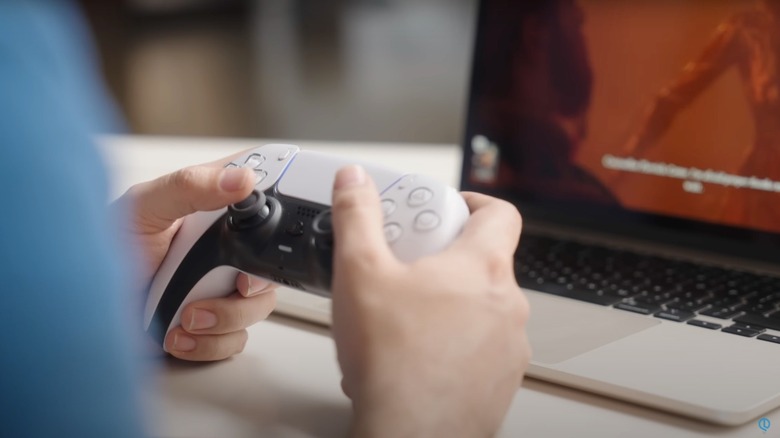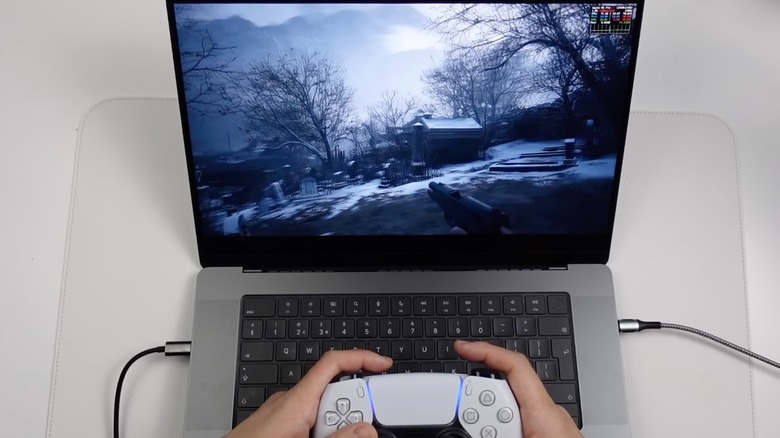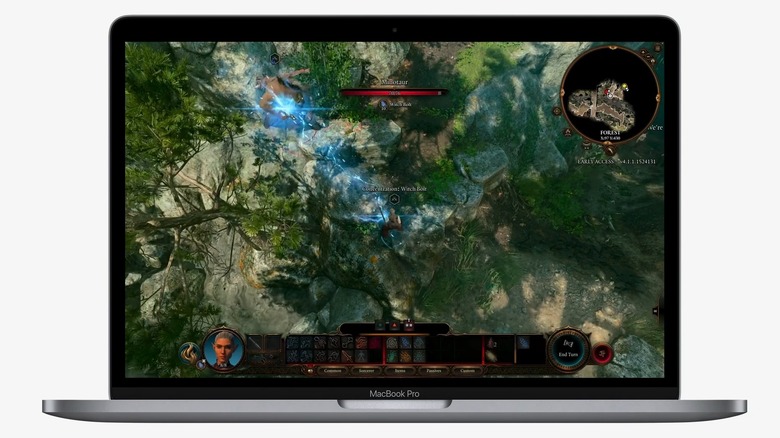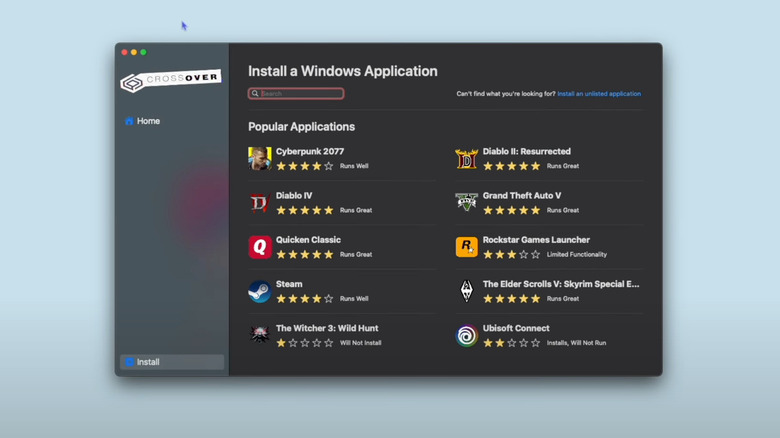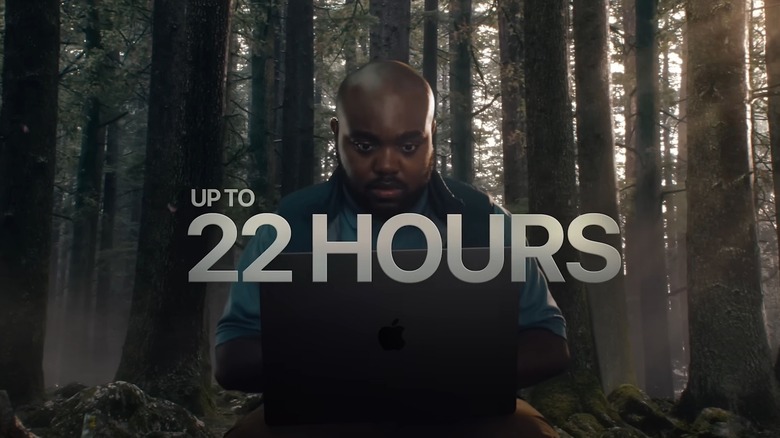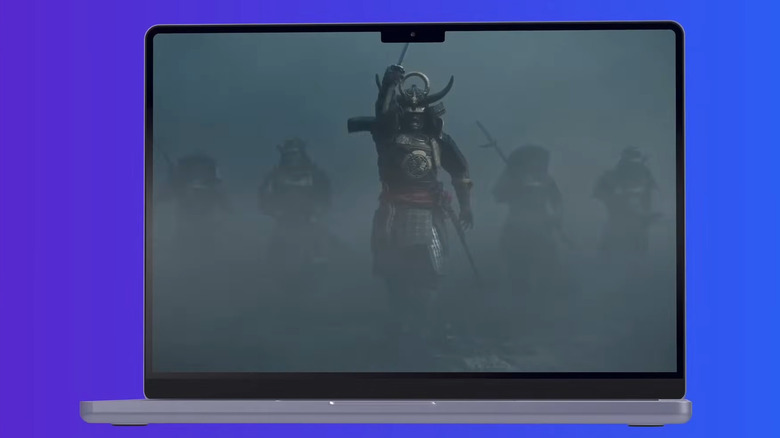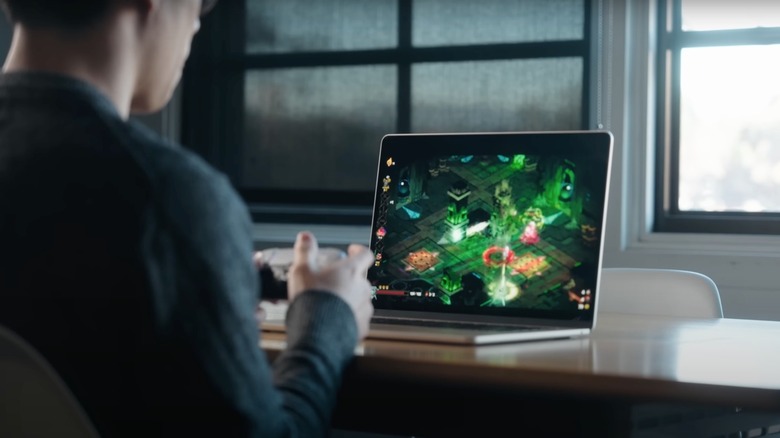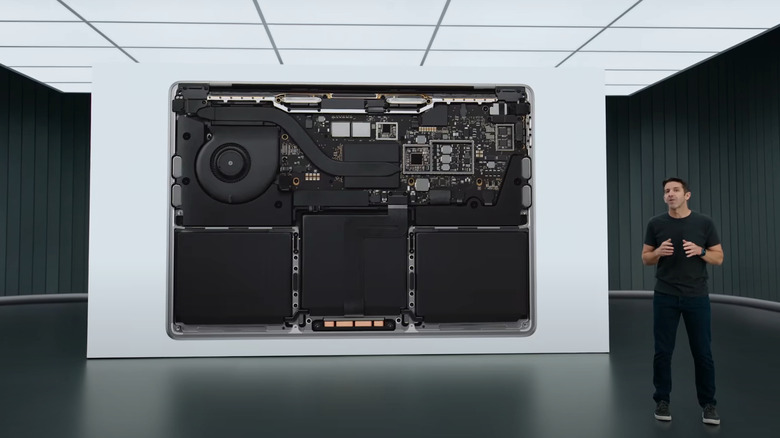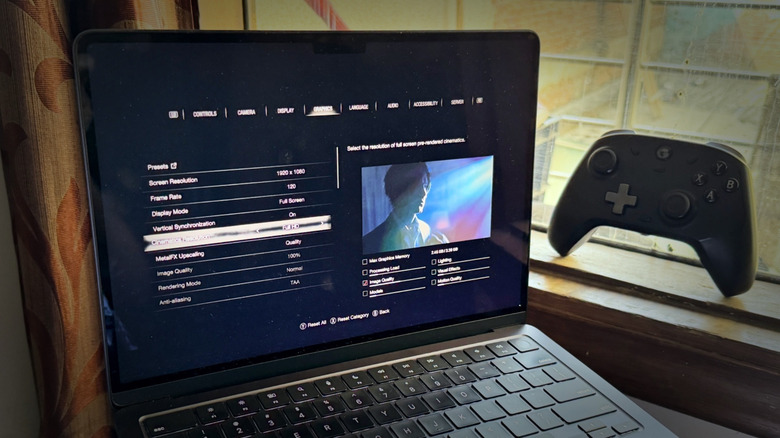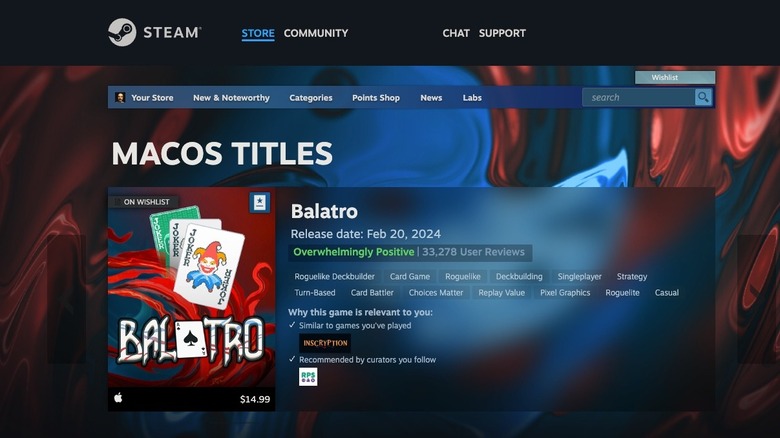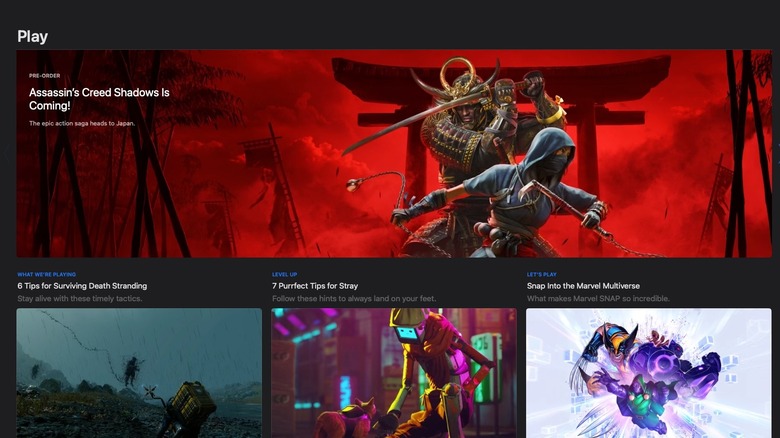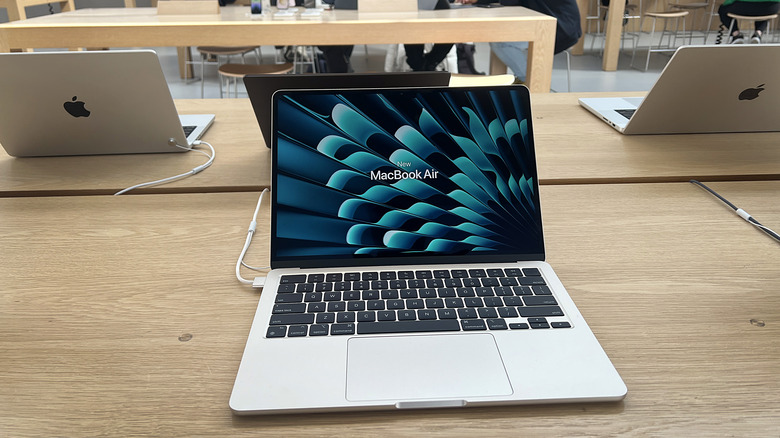Is Gaming Possible On A MacBook Pro? Here's What You Need To Know
Windows and PC gaming are as inseparable a pairing as bread and butter. If Xbox, Playstation, or Nintendo Switch don't suit your fancy, then you take a seat at your computer desk and fire up Microsoft's latest OS, simple as. Historically, asking whether you could game on Apple's MacBook Pro lineup was like asking if your Mini Cooper could tow an RV. Yet watch any Apple event in recent years and you'll hear Tim Cook and other company execs working double-time to fit the word gaming into their MacBook Pro segments, especially after the massive performance leap of the Apple silicon M-chip architecture. The talking heads at WWDC would have you believe that your Mac can now replace your gaming PC. Can it really, though?
Credit where credit is due, Apple's uncharacteristically large push into gaming territory isn't just blowing smoke. It's system on a chip (SoC) hardware offers stunning performance at an absurdly low power draw, and WWDC has introduced new gaming-oriented features, but it's still best to take everything Apple's marketing team says with a grain of salt. If you're eyeing the latest MacBook Pro M3 to supplant your Windows rig, hold off for a moment while we take a look at the current state of Mac gaming.
The MacBook Pro can handle AAA games
The Apple silicon revolution has left jaws on the floor with how much performance can be squeezed out of a device that offers all-day battery life. Perhaps more impressive is how the integrated GPU in the M-series SoCs does away with the requirement for a brick-sized dedicated Nvidia graphics card. And we're not talking exclusively about the marked-up Pro and Max chips; the starter configuration found in the cheapest MacBook Air M3 is a powerhouse, too.
YouTuber MrMacRight tested 15 AAA games on the M1 MacBook Pro. He included last-gen titles like "The Witcher 3" in addition to the recent "Baldur's Gate 3," and achieved a playable framerate at 1080p on medium settings. This is impressive, even if it pales in comparison to a Windows gaming rig. Keep in mind that the M1 chip has been succeeded by the M2 and M3, and the M4 recently launched with the new iPads. Some reviewers have concluded the M3, as one example, is as much as 60% faster than the M1. So if you buy the M4 MacBook Pro releasing in Q4 2024, it's probably safe to say you'll have performance to spare for the latest games.
Apple has made many recent gaming strides
A large chunk of the reason gaming was never really a thing on Mac — until now — was Apple's reluctance to get the ball rolling. Then at WWDC 2023, Apple announced its Game Porting Toolkit. The name says it all. With the Toolkit, devs can more easily convert their Windows-only titles to Mac, easing the financial burden on studios and hopefully reducing crunch. Toolkit includes invaluable features such as MetalFX Upscaling, an alternative to Nvidia's DLSS and AMD's FSR that allows gamers to achieve higher frame rates. We'd need an entire article to detail just how comprehensive this suite is; think shader converters, game controller frameworks, and other vital tools.
Apple also upped the ante on the software side of things, with the Windows-like macOS Game Mode, as well as an overhauled Game Center that lets gamers play games and earn achievements without installing any extra software. It's a good start, but alas, there's work to be done. Users argue that Apple needs to make its Arcade more friendly to the non-mobile gamer crowd and develop its own first-party exclusive titles a la Sony and Xbox, among other things. Some worry that Apple (as it is wont to do) will stop after these half measures, but here's to hoping that won't be the case.
Compatibility tools can make most games playable
If you can't beat 'em, join 'em — and if you can't join 'em, translate 'em. That's the philosophy of the Steam Deck, which we adored in our review. Valve's portable console translates Windows games so they play on the Steam Deck's Linux-based system as if they were native titles. It comes at a small hit to latency and performance, but the end result is that it's irrelevant whether or not the devs brought your favorite game to your platform of choice. And you're in luck, because this Steam Deck superpower is at the disposal of the MacBook Pro.
The first option is to go with Apple's own Game Porting Toolkit. Though you'll need to clear some technical hurdles, folks have used it to run demanding AAA blockbusters like Cyberpunk 2077 and Diablo IV. Third-party options simplify the process. CrossOver Mac is one of the best, though it will cost you $74. If you prefer a free option, try Whisky or PlayOnMac.
To be clear, every game you play via these compatibility tools will require tinkering, and the experience won't be anywhere near as pleasant as launching a native title. Some games simply will not work, or portions of them will be broken. Despite this, it's comforting to know that your non-Mac games are finally accessible.
MacBook Pro battery life is excellent for gaming
Gaming laptops have always had one fatal flaw: Their battery life is atrocious. You're lucky to get a couple of hours of playtime on a midrange Windows gaming laptop — if you want more than that, you'll have to lug around a bigger, more expensive device. Even the Steam Deck suffers from unremarkable battery life. This is the one area where Apple roundly defeats the competition. A baseline MacBook Pro boasts 22 hours max battery life whereas Windows laptops with great battery life are lucky to tap out at 18. You'll likely game much longer with an Apple device, especially since performance doesn't tank on a MacBook Pro as soon as you unplug it from the wall.
YouTuber Matt Talks Tech did a series of demanding performance tests (exporting video, running game benchmarks, and so on) on the M1 family of chips and got a solid 5 hours of battery life on both MacBook Pros. For reference, the Asus ROG Zephyrus (a nearly $3,000 laptop) gets similar battery life and costs twice as much as the entry-level M3 MacBook Pro. Apple's offering is hard to beat in this category, especially when you consider it has a 120Hz XDR screen running at 3024-by-1964 resolution. So not only will you be able to spend half a day gaming on battery, you'll have a stunning Mac screen to immerse yourself in the details.
More AAA games are releasing on Mac day one
The track record for Mac releases isn't good. Whenever we get a Mac-ported game, it typically follows years after the initial Windows launch. Just take a look at "No Man's Sky," which Apple loudly and proudly proclaimed would arrive on Mac by 2022, only for it get delayed until mid-2023. Meanwhile, Windows users had been enjoying it since 2016. If that doesn't explain the sorry state of game releases on Macintosh, we don't know what will. Luckily, recent news paints a picture of a brighter future.
"Assassin's Creed: Shadows" made waves as the first title in the series to take place in Japan, and perhaps more surprising than that was the announcement that it would be coming to Mac the same day as everywhere else. "Assassin's Creed" is one of the biggest franchises in video game history, so for Apple users to get their hands on it at the same time as Windows is a big deal.
Also worth noting is AC's reputation of moving the graphical needle with every release. If Ubisoft believes the Mac can handle it, that says a lot about the platform's raw power and capabilities. Ubisoft is one of the biggest publishers on the scene, too, so other developers may follow suit, provided sales on the Mac version convince them it's worth their while.
Gaming on Mac is too expensive
Let's not beat around the bush here: Apple is a luxury brand and often outrageously expensive. Some argue it's worth the money — pointing to the premium build quality, longer-term OS support, better default software, and higher resale value — but the fact of the matter is Apple is not the bang-for-your-buck choice. The tech giant won't sell you the MacBook Pro for a penny less than $1,599. Meanwhile, plenty of affordable pre-built gaming desktops run as low as $499 — yet another reason Windows reigns supreme as the gaming PC of choice. With inflation at record highs and wages stagnating, Mac as a gaming platform will be out of the question for most.
It's not just that there's a huge price disparity, there's a graphical one, too. A Windows PC that costs half as much as the MacBook Pro can usually keep pace with it in gaming benchmarks. When comparing two devices at a similar price point, the MacBook Pro is left far, far behind. The Asus ROG Zephyrus we mentioned earlier can play Cyberpunk 2077 on Ultra settings (with Ray Tracing enabled) at a respectable 75 FPS. The MacBook Pro M3 Max (which starts at $3,199, about $300 more than the Zephyrus) can only reach 40 FPS even with Ray Tracing disabled — though to be fair, the translation could be dragging down the performance some.
Storage and memory will be an issue
Apple has stirred up a lot of outrage over the years because upgrading its systems feels like downright robbery. Going up from 8GB of RAM to 16GB — or from a 512GB SSD to 1TB – costs $200 a pop. If you're determined to use a Mac for gaming, you'll probably have to bite that bullet. Most modern games need 16GB of RAM and, depending on the title, take up as much as 100 to 200GB in storage space. "Assassin's Creed: Shadows" is expected to sit around 100GB minimum, for instance. Upgrading both RAM and storage will raise the price of a new MacBook Pro from $1,599 to $1,999. Yikes.
The problem gets worse when you consider that you can't ever upgrade your storage on a MacBook Pro once you've bought it. This isn't Apple playing dirty, it's simply because the RAM and SSD are part of the SoC and can't be replaced. The MacBook Pro specs you pay for are the ones you'll keep until the day your device croaks. Fortunately, there's some good news here. You can always buy a portable SSD and use it with Mac's native Thunderbolt. Speeds won't be that much slower than the Mac's internal NVMe. Though it's not ideal to have to play with an external hard drive sticking out the side of your laptop, it does at least let you bypass Apple's storage racket.
You'll probably be stuck gaming at 1080p
1080p used to be the target resolution for gaming in the early 2010s, but now many gamers aim for 1440p. If they've got a lot of disposable income, they go for the holy grail of 4K 2160p — roughly double the pixel density of 1080p. The leap from 1080p to 1440p isn't as drastic as the one from 720p to 1080p, but it is noticeable, and most modern hardware can handle it. The Playstation 5 and Xbox Series X consoles push 4K 30 FPS in their respective fidelity modes. PC hardware can too, though it will depend on your setup. Then there's Mac. The latest MacBook Pro M3 playing a native copy of "Resident Evil 4" gets a stable 30 FPS at 1080p on recommended settings. If you have the M3 Max chip, you can bump up the resolution to 1870p at 60 FPS while on the Prioritize Graphics setting. The latter sounds great on paper until you consider the M3 Max costs a minimum of $3,199.
In all likelihood, your Mac gaming experience will sit comfortably in the 1080p region as graphical requirements continue to steepen. Some would argue (with reason) that 1080p simply is not acceptable for Apple's premiums. That said, 1080p isn't going to feel that much worse than a higher resolution when sitting at arm's length from the screen. That's the distance you should already be using your devices at, anyway.
Native Mac titles are few and far between
Remember, native titles are preferable over those played with a compatibility layer since you'll be getting the best possible performance and the lowest latency. The problem is that there are embarrassingly few Mac titles to begin with. Taking a look at Steam, there are approximately 20,000 titles with a native Mac version — a sizable portion of which stopped working as soon as Apple yanked 32-bit support. That may sound like a lot until you compare it with Windows' nearly 200,000 available titles. Remember, it's rare for most games to get a day-one Mac release, if they ever get one at all. Suppose, for example, you were looking forward to a popular release like "Ghost of Tsushima" on Mac. Keep dreaming; the title is Windows-only, and will likely remain that way for the foreseeable future as most releases do.
There is reason to hope this will change. "AC: Shadows" being available on Mac for release day suggests other devs may follow suit. It will certainly be easier for them with the Game Porting Toolkit. For casual gamers, the lack of titles may not be all that disheartening. 20,000 games is more than any one person can play in a lifetime, so if you're not picky, you'll never run out of entertainment.
Game translation comes with a lot of caveats
Game translation, as we've discussed, worsens performance and latency to a slight degree. That's a plenty acceptable tradeoff for most; just look at the Steam Deck, which already boasts millions of happy customers. Compatibility overhead is more of an issue for low-spec systems like the Deck anyway, which means the hit on MacBook Pro isn't as harsh. Sadly, reduced performance isn't the only tradeoff that comes with compatibility layers. Using the Steam Deck (a translation-first machine) as a guide, it's very common for anti-cheat to break somewhere in the translation pipeline — or worse, never work in the first place. Many, many online games that use an anti-cheat system are simply off the menu for anyone using game translation, but we're only just scratching the surface here.
Steam Deck owners are well accustomed to spending a not-insignificant amount of time figuring out how to get each and every game in their library working. Sometimes their controllers are only semi-functional. Sometimes they need to test experimental (i.e. unstable) versions of compatibility software until something sticks. Settings often must be tweaked with precision to get AAA games running at an acceptable frame rate. All these issues will apply to the MacBook Pro too, especially since Apple hasn't yet built an easy-to-use translation layer like the Steam Deck's Proton.
The App Store experience is... bad
A good digital game store is a key pillar of PC gaming now that CDs have been put out to pasture. Steam on Windows is the gold standard, a one-stop-shop for all your gaming needs. It's where you keep your games up to date, diagnose problems with them, and stream them to other devices. You can connect with friends and communicate during games, engage in forum discussions, and keep up with the latest developer news. The macOS App Store, the primary place to buy native Mac titles, doesn't hold a candle to Steam.
Where do we even begin? For starters, the App Store hasn't been popular for years in a general sense, not just for its failure in the gaming department. For gaming specifically, it's simply not built for it. There's no easy way to view your game library, to find new games, or to do something as simple as download a game to another drive. Functions like the Game Center only appear when you open a game; otherwise, you'll have to jump into the settings. You can use Steam on Mac (and we recommend that) but some Apple shenanigans will spoil the pudding. Take "Resident Evil: Village." It has a native Mac port, but you can't play your Steam copy. Instead, you have to purchase it again on the App Store.
You can game on Mac, but should you?
After all we've discussed, should you pull the trigger on a MacBook Pro for gaming? In this writer's opinion, probably not. The progress Apple has made with its M-series chips and things like the Game Porting Toolkit is laudable, and its advantages in battery life deserve mention. But Apple desktop gaming is arguably still in its infancy. There are too few native titles to make the investment worth it. Even if there were more, few people would find enough financial justification to get a MacBook Pro over a more affordable, more powerful Windows rig. Other stumbling blocks like the unsatisfactory App Store need ironing out, too.
The only situation where we do recommend it is if you already own a MacBook Pro as your daily driver. All you'd need at that point is a decently-sized external SSD to hold your games, and the patience to get incompatible titles working on Crossover or Whisky. Otherwise, come back in 10 years to see where Mac gaming is at.
Our hope is that Apple takes a page out of Valve's book with the Steam Deck. Imagine a future where a seamless, built-in Apple translation layer lets you play whichever Windows game you like with a simple double-click. That alone could probably incentivize more people to get a Mac as both their productivity and gaming device — more Mac gamers means more reason for devs to make Mac ports. And so on.
